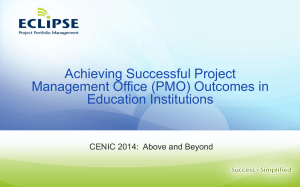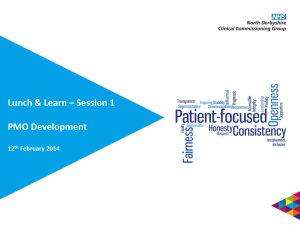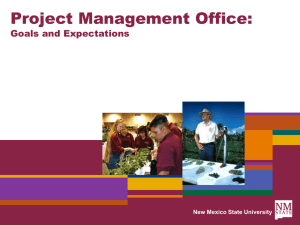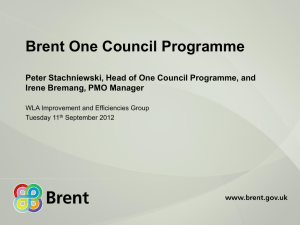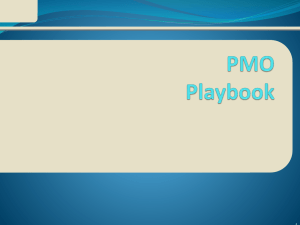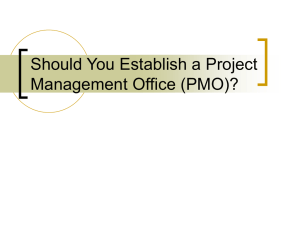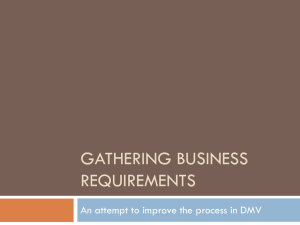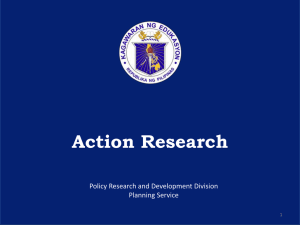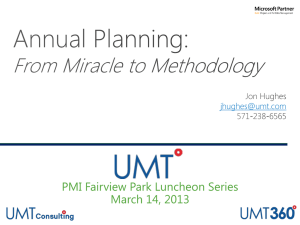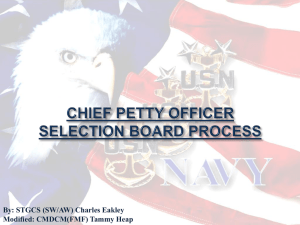project management office(PMO)
advertisement
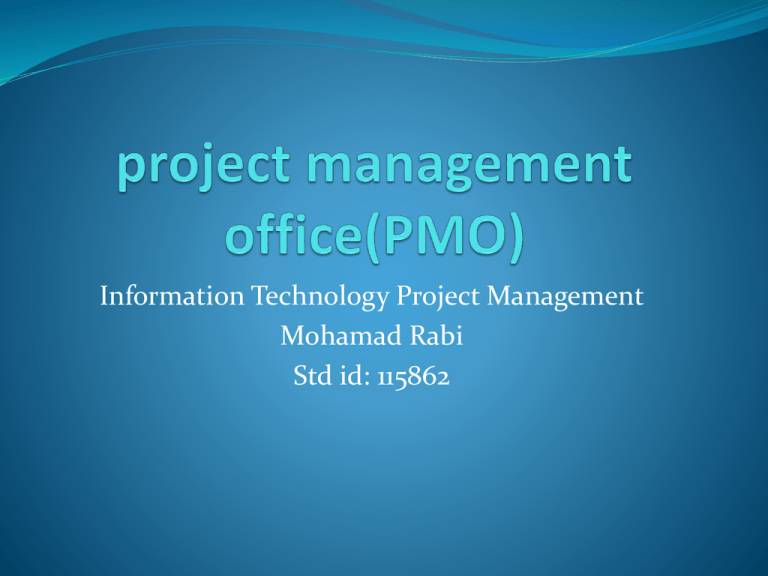
Information Technology Project Management Mohamad Rabi Std id: 115862 Table of content What Is a PMO? PMO Types PMO Roles Goals of a PMO PMO Implementation Current State Assessment Future State Vision Gap Analysis Implementation Strategy Implementation Plan PMO Services Basic PMO Services Advanced PMO Services What Is a PMO? A PMO is a project or program management office An organizational entity with full-time personnel to provide a wide-range of project management support and services across the entire organization also referred to as a project office, project support office, or center of excellence PMO Types Different type of project management office Type I: Project Reporting Type II: Project Management Infrastructure Type III: Coaching and Training Center Type IV: Resource Center / Center of Excellence PMO Roles Chief Project Officer – owns project management for the enterprise, business unit, or department. Expert and mentor in all areas of project management. Project Manager – directs and coordinates project activities Project Planner – handles consolidating and managing of project plans including schedule development, budgeting, and resources Project Librarian – maintains repository of project knowledge (records, standards, methods and lessons learned) Best Practice Expert – develops and maintains project management methodology and processes PMO Roles cont.. Process Improvement Manager – prepares and executes process quality assurance plans. Documents and maintains project processes and standards Resource Manager – works with human resources in providing job descriptions, roles and responsibilities, and how to measure performance against those roles and responsibilities Communications controller – handles external and internal communications relating to projects within the PMO Change control expert – responsible for organizational change management, develops and maintains issue resolution, and change control processes PMO Roles cont.. Executive administration – provides secretarial support and performs back office tasks Technology services – manages and coordinates technology issues Goals of a PMO Report project status consistently and effectively Review project progress on an ongoing basis to ensure on-time, on-budget completions Provide project management tools to facilitate improved project performance Separate the right project work from the ‘wrong’ project work Enable a higher level of project management PMO Implementation Current State Assessment Future State Vision Gap Analysis Implementation Strategy Implementation Plan Current State Assessment Mission : Aligns organization to value it provides to the Business – What the organization does, how, for whom Vision : Perfect organization in a perfect world – State what the organization is striving to achieve Goals – What the organization is trying to accomplish (high level) – Aligned to business benefit – May take multiple years to achieve Current State Assessment Strategy - How-to– Overall plan and course of action to achieve goals – Based on external environment and internal capabilities Objectives – Low level statements – Describe what this organization will achieve this year Principles – Moral and ethical statements – Rules of behavior, how you value people – How people will resolve conflict Current State Assessment History – Understanding major past events – General attitude toward change – How successful have projects been in the past? Culture – “How we do things around here" – Informal (and formal) rules Current State Assessment Governance – How the management structure functions – How you accomplish objectives using management Clients, Customers and Suppliers Stakeholders Business processes Other initiatives that may conflict Organization structure and how it helps or hinders project success Current State Assessment Staff – Roles – Responsibilities – Skills & competencies – Makeup Locations – One location, multiple location, – Cultural differences – Language differences Future State Vision Clients / customers Suppliers Stakeholders Products and services Other initiatives Staff, roles, responsibilities, and skills Future State Vision Pick areas that make most sense Similar to Current State categories, but not exact – Some categories only apply to Current State This is a requirements gathering process – No right or wrong – Only right and wrong for your organization – Need to identify requirements and build consensus Iterative process – Your future state is likely to change when you see what it will take to reach it Gap Analysis What is the gap between current state and the future state? Gain consensus The Gap Analysis is a means to an end, not the end itself Implementation strategy Use the Gap Analysis Provides a framework to make decisions and Sections – Overall scope – Enablers and barriers – Risks – Implementation strategy statements (how-to) – High-level approach Implementation plan Use the Gap Analysis and Implementation Strategy to Identify : – Projects – Timeframes – Resources – Deliverables Create the roadmap to move toward your future vision Basic PMO Services Consolidated status reporting – Basic PMO service – Provides consolidated view of all project status Project dashboards – Graphic, visual display – Charts and graphs for overall status and trends Basic PMO Services Methodology management One of the basic PMO responsibilities Consistent and common project management methodology – Processes – Procedures – Best practices – Templates – Standards and guidelines Make sure the methodology is scalable Basic PMO Services Training Many alternatives – Instructor led and computer based – Seminars / webinars – Books / magazines Project Management Coaching – Usually one-on-one or small group – Advice is based on coach training and experience and is specific to the people being coached Basic PMO Services audit every project – Validate compliance – Provides opportunity for coaching – Use quality assurance techniques Documents repository – Need a place to house documents – Can‘t reuse prior work if you can’t find it – Include methodology, PMO documents, and welldone examples of completed work More Basic PMO Services Metrics Collection – Project focused and PMO focused – Project management value focused – Organization scorecard focused – Benchmarking Organizational Assessments Periodically determine progress of PM implementation – Look at all services offered – Analyze all metrics and fee Advanced PMO Services Provide training and coaching Establish supporting infrastructure Designing a project management career path Collecting project metrics for improved estimating and process improvement Defining project time-reporting requirements Providing product management for PM tools Advanced PMO responsibility Establishing a portfolio management process Portfolio management – Improved resource allocation – Improved alignment of the work – Improved balance of work Portfolio management and the PMO – PMO sees all projects – PMO serves as a central coordination organization Common resource pool – Skills inventory – Current assignments Thanks for your Attention
